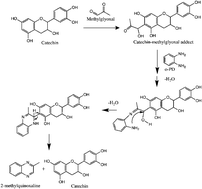Response surface methodology as optimization strategy for reduction of reactive carbonyl species in foods by means of phenolic chemistry
Abstract
Response surface methodology (RSM) was utilized to investigate the dose–response relationships of a phenolic mixture (catechin, genistein and daidzein) as a pre-thermal processing technique to reduce reactive carbonyl species (RCSs; glyoxal, methylglyoxal and 3-deoxyglucosone) in ultra-high temperature (UHT) bovine milk. A modified derivatization technique for RCSs was developed to overcome quantitative error caused by interference from the phenolic compounds. For the statistical analysis, a Box–Behnken 3-factor (catechin, genistein and daidzein) 3-level (0.17, 0.645 and 1.12 mM) design was employed. In general, all phenolic mixtures were able to reduce RCSs in UHT milk; some compositions reported RCSs levels at or below levels reported in pasteurized milk. Predictive models with no significant lack of fit (p > 0.05), high R2-values (0.886–0.979) and good predictive power were developed. ANOVA analysis of the glyoxal levels indicated that only linear effects of each phenolic compound had a significant effect (p < 0.05) meaning that no significant interactions between the different phenolic compounds influenced glyoxal levels. Linear, cross product and quadratic effects of factors were reported (p < 0.05) for methylglyoxal, indicating more complicated interactions between the phenolic compounds. Both linear and quadratic effects were also reported (p < 0.05) for 3-deoxyglucosone. Overall, based on canonical analysis, catechin seemed to be the most influential factor for the reduction of RCSs in UHT milk. In summary, RSM provided a basis to understand phenolic structure–reactivity and to optimize the composition of a tertiary mixture of phenolic compounds for reduction of RCSs in UHT milk.

- This article is part of the themed collection: The Maillard reaction in food and nutrition

 Please wait while we load your content...
Please wait while we load your content...